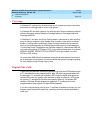
MERLIN LEGEND Communications System Release 6.1
Network Reference
555-661-150
Issue 1
August 1998
Feature Interactions
Page 3-5Caller ID
3
Caller ID 3
For 6.1 and later systems, Caller ID and Automatic Number Identification (ANI)
information is conveyed across the private network when PRI tandem trunks are
used to route the call
and
under the following conditions:
■ The call is transferred using a DSS with one-touch transfer with automatic
completion.
■ The call is received on a PSTN trunk assigned to ring directly into a calling
group with a non-local member.
■ The call is received on a Personal Line and the principal user has activated
Forward to a non-local extension and the Forward Delay option is set to
one ring.
■ The call is transferred to a user that has activated Forward to a non-local
extension and the Forward Delay option is set to one ring.
For Release 6.0 systems, Remote Call Forwarding can be used in combination
with Caller ID on a loop-start PSTN line connected to a networked system’s 800
LS-ID line/trunk module (loop-start ID delay must be on). To pass Caller ID
information across the network when a call is transferred, set the Remote Call
Forwarding Delay to one ring. Transfer of the call must be completed before the
call is forwarded.
For 6.0 and later systems, Caller ID and ANI information is not conveyed across
the private network under the following conditions:
■ The call is routed over T-1-emulated tie trunks or analog (E&M) tie trunks.
■ A call is manually transferred by a user or is transferred by an automated
attendant.
Calling Restrictions 3
Outward restrictions, toll restrictions, Allowed/Disallowed Lists, Night Service
restrictions, Extended Station Status restrictions, and the prohibition of trunk-to-
trunk transfers do not apply to calls made to extensions in the non-local dial plan.
These restrictions are still active for other calls.
To prevent toll fraud, dial-access to pools must not be permitted for pools of
private network trunks.
CAUTION:
!
Unless networked systems are co-located, each system should have at
least one loop-start line connected to the PSTN. The line is required to allow
connection of a power-failure telephone to the Power-Failure Transfer (PFT)
jack on a module as a power outage backup and for correct routing of
emergency and other N11 calls. To ensure that the correct services are
reached, if the loop-start line is used for emergency or other N11 calls, it


















